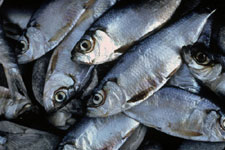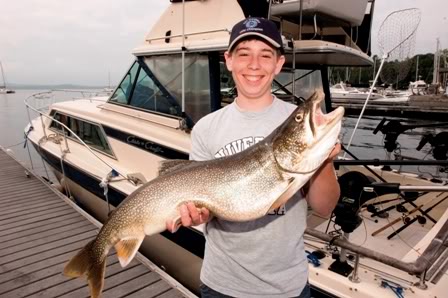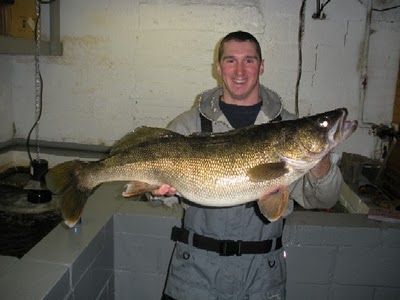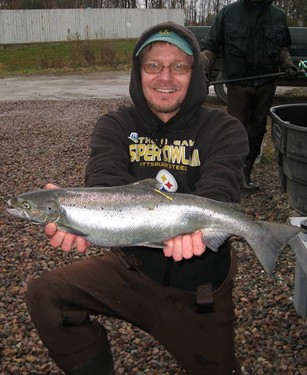Alewives, | |
|
Alewives are now established as a dominant forage fish in Lake Champlain. The advent of this invasive baitfish has disrupted the natural food chain, devastated the commercial smelt fishery and profoundly impacted emerald shiner and perch populations in Lake Champlain. The alewives tendency to die off in mass threatens to severely diminish the forage base at any given time. Fish culturists stocking Lake Champlain’s game fish are suddenly challenged with new and more costly treatments to combat the vitamin B12 deficiency and early mortality syndrome (EMS) that results in young hatchery brood when the spawning adults feed primarily on alewives. The good news is that there has been preliminary success treating EMS in the hatchery and the initial doom and gloom predictions of this invasion have been tempered by some positive dynamics. There could be a silver lining in the proverbial dark cloud. A plentiful alewife forage base appears to be increasing the growth rate of predator fish including lake trout, Atlantic salmon and walleye. Ample alewives, along with the more thorough and timely lamprey control process of the past two years have resulted in record breaking fish catches on Lake Champlain!
| |
 The Lake Champlain Management Cooperative knows that constant changes in the lake’s ecology call for evolving, or adaptive, management methods. On Lake Champlain, fish diseases and invasive or nuisance species are continuously testing fisheries managers resolve. Treatment of alewife related early mortality syndrome in hatcheries and new and improved lamprey control methods are examples of this adaptive management. | |
|
Alewives, a member of the herring family, are native to the Atlantic Ocean. The fish was likely dubbed “alewife” due to their puffy bellies, after the stereotypical plump women who operated ale houses in England. Freshwater alewives are about half the size of their saltwater cousins, averaging about 6 or 7 inches, compared to the 10 to 11 inch average length of the Atlantic variety. On the East Coast Native Americans and New England settlers used alewives for food. The freshwater alewife has a bigger head, enlarged by salivary glands that are overworked to maintain a mineral salts balance in its blood similar to that of its ocean relative. A freshwater alewife also has an atrophied or stunted thyroid, a condition which leaves it bonier, with a lower fat content, and less suited for human consumption. Today, along the Atlantic Coast, the Atlantic Salmon Federation is working to restore historic alewife runs because as a transitory or part-time food supply the alewife provides a good source of nutrition for salmon. Great Lakes Account In the Great Lakes system alewives were first discovered in 1873 on Lake Ontario. They were found in Lake Erie and Lake Huron in the 1930s, and Lake Michigan and Lake Superior in the 1940s and 1950s respectively. When sea lamprey in Lake Michigan killed off many of the native predator fish like lake trout and burbot the alewives thrived and over populated the lake. In 1967 a major die-off occurred on Lake Michigan. Wind-rows miles long of dead, rotting fish washed up on beaches around Chicago and other populated shoreline communities creating a social outcry for some sort of control. Within a few years fisheries managers were controlling lamprey and stocking Pacific Salmon and other game fish to predate the booming alewife populations. A sport fishing cottage industry blossomed. Alewive populations are now thriving in Lake Champlain so the need for a healthy predator fishery is paramount. As seen historically on Lake Michigan, alewife control can’t happen without thorough and timely lamprey control. Lake Champlain officials knew for decades about the threat of alewives establishing a population here. Alewives are naturally occurring in the St Lawrence River. Small but alarming populations of alewives appeared in the 1980’s on the Richelieu River and on the Pike River, which drains into Missisquoi Bay. Several years ago alewives were either accidentally or deliberately introduced into near-by Lake St. Catherine in Vermont. Because a vector existed connecting Lake Champlain’s southern end with Lake St. Catherine, a potential out-migration or escapement was feared. At that time Vermont officials chose not to spend the money to eradicate the invasive baitfish from the inland lake. In 2003 Quebec Ministry of Wildlife and Parks officials found adult alewife specimens in the northern sections of Missisquoi Bay. Then in 2004 Fish and Wildlife representatives found a single adult alewife in the main lake near Isle le Motte. Soon coordinated sampling efforts were expanded throughout Lake Champlain. In 2005 Vermont officials and students at the University of Vermont collected several more alewives of multiple age classes in the main lake and the inland sea. At that time Vermont fisheries biologist Bernie Pientka led much of the sampling effort. Pientka soon announced the bad news to the press, “The collection of both juvenile and adult individuals from different areas of Champlain suggests that alewives are now reproducing in the Lake.” In the fall of 2008 the first documented die-off manifested itself on the shores of the Inland Sea and later in early 2009 another mass mortality occurred on the south end of the main lake. Alewives along with their boom and bust tendencies were established on Lake Champlain. Alewife Characteristics Alewives live in deeper waters during mid-winter. They move along the bottom through the intermediate depths in late winter and early spring. They migrate toward the shallower shorelines, tributary deltas and into rivers to spawn during May, June and July. In autumn, they migrate back to the intermediate areas. The young hatch during the summer and spend most of their first two years at mid-depths in the lake. This pelagic baitfish feeds on zooplankton and typically out-competes native fish with similar diets. They cause changes in plankton distribution, composition, and size. When zooplankton becomes scarce, alewives will feed on larvae of resident fish species. Alewives are extremely temperature sensitive. Following migratory paths through rapidly changing lake water temperatures can have fatal consequences. When these fish die in large numbers fouled shorelines result along with the obvious accompanying malady as the odorous fish decompose. Under the surface of these die offs are more complicated issues. Depending on the extent of a die-off, the forage base for many other fish species can become scarce. A plunge in water quality can occur, phosphorous levels may spike and phytoplankton populations can fluctuate wildly. Some biologists theorize that the fishery could crash if the forage base declines enough. Fortunately, Lake Champlain is divided into several sections which may serve to protect the fishery from a total collapse. In addition to food chain disruptions and mass mortality issues, alewives have also been identified as the cause of early mortality syndrome in Atlantic salmon and trout. A thiamin or vitamin B12 deficiency of fatal consequence occurs in a large percentage of the offspring of lake trout and Atlantic salmon when alewives are a predominant part of their diet. Biologists suspect bacteria in the stomach of the alewife is the culprit that produces an enzyme called thiaminase, which breaks down the thiamine. Lake trout and Atlantic salmon are particularly susceptible to the deficiency. At the Ed Weed Fish Culture station, manager Kevin Kelsey first noticed alewife related early mortality syndrome in salmon and trout in the fall of 2009. Adaptive management methods for treating EMS were promptly implemented. Injections in adult fish and a thiamine bath for larval stage fish worked and symptoms associated with EMS vanished. While the treatments are costly and labor intensive, managers seem to have found a way to clear this latest hurdle. Record Breaking Catches When fisheries managers are looking for broad baseline statistics or status information regarding a particular watershed they often survey anglers to complement their own sampling data. Charter businesses and tournament fishing events with the many fish they catch, offer a good sampling of a fish conditions and growth rates on a particular watershed. Tournament and charter fishing statistics offer information about a fishery on a year to year basis and provide managers with long term trends and indications regarding the health of a fishery. Some biologists initially refused to acknowledge the suggestion that alewives were causing the increased growth in lake trout and other predator fish. They pointed to lamprey control as the primary reason we are seeing bigger fish on Lake Champlain. But just two years ago lamprey wounding rates peaked at 98 hits per 100 fish sampled. It was only two seasons ago that the Poultney River was finally treated and many anglers now know it takes a full four years to see results of a treatment and even longer for the entire watershed to see the benefits from thorough lamprey control. | |
 Patrick Dupont proudly displays his LCI record 15.9 pound Lake Trout caught in the 2009 tournament | |
|
A few years ago, Lake Champlain anglers were catching lake trout in tournaments that reached top weights of 12–13 pounds, and that was in the top ten categories where hundreds of anglers participated. Last season several trout over 15 pounds were reported and during the Lake Champlain International fishing tournament young Patrick Dupont entered a record 15.9 pound lake trout that smashed the derby benchmark. During the summer of 2010 the LCI record was again broken and several lake trout in the 18 - 19 pound range were reportedly caught by August. In February of 2010 Richard Levesque of West Swanton broke a Vermont State record and a Lake Champlain record when he pulled a 14.55 pound walleye through a hole in the ice while hard-water fishing after dark. In the fall of 2009, Vermont Fish and Wildlife personnel recorded record numbers of Atlantic salmon returning to the hatchery brook at the Ed Weed Fish Culture Station on Grand Isle. Fish sampling took place at the brook and at a number of other tributaries and locations on Lake Champlain. Over 700 salmon were sampled with an average length of 21”. More than 20 of these were greater than 25” long with fish 28”, 30” and 31” in the mix. A 31” fish would weigh approximately 15 pounds. The recent 2010 sampling proved even better! The modern hook and line record for an Atlantic salmon in Lake Champlain is a 12 pound 10 ounce fish caught in Vermont waters in 1994 by Brian Latulippe. If alewives are not causing these growth trends, and lamprey control is the primary reason for recent records then how big will the fish be in two more years, when the full benefits of lamprey control are finally seen? Most biologists I speak to are now starting to admit the alewives are having an impact. If you ask this charter Captain, alewives are a big part of the equation in the recent growth trend. As fishermen flock to Lake Champlain in hopes of being the next angler to notch a record in their belt even more standards may fall by the wayside. Like the gold rushes of the mid 19th Century, next season Lake Champlain may witness the “Silver Rush of this decade”! | |
 This Vermont State 14.55 pound record walleye was caught by Richard Levesque while ice fishing on Lake Champlain in February, 2010 | |
|
| |
 A Vermont Fish and Wildlife representative involved in 2009’s fall sampling gently holds a healthy trophy female Atlantic salmon. One fish captured last fall was measured at over 31 inches and if caught by an angler would likely have crushed the modern Lake Champlain record. | |
| Back to the home page | |